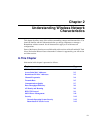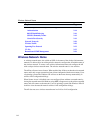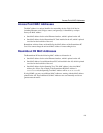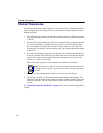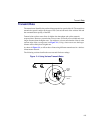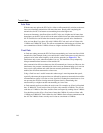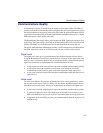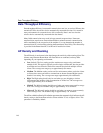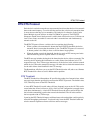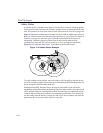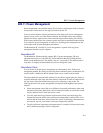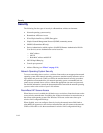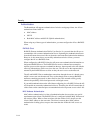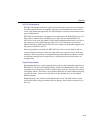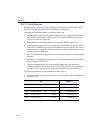
2-9
RTS/CTS Protocol
RTS/CTS Protocol
Each device in a wireless network can sense transmissions from other devices in its network
that use the same frequency. To avoid collisions and lost data, a device only transmits when
it senses that no other device is transmitting. This behavior is referred to as the Carrier
Sense Multiple Access/Collision Avoidance (CSMA/CA) protocol. The RTS/CTS
(Request to Send/Clear to Send) protocol is useful when collisions do occur. Collisions can
occur if two clients are unable to sense each other’s transmissions and simultaneously
transmit to the AP.
The RTS/CTS protocol forces a wireless device to perform the following:
• When a packet to be transmitted is shorter than the RTS/CTS threshold, the device
transmits when it senses that the medium is free. The RTS/CTS protocol is not used.
A shorter packet is less likely to have a collision than a longer packet.
• When the packet exceeds the threshold, the device sends an RTS message and waits
until the receiving device responds with a CTS message.
The RTS message includes the length of the frame that the device wishes to transmit. The
receiving device includes this information as a radio-silence time indicator in its CTS
response message. The CTS message announces to all the devices in the wireless network
which device is allowed to transmit its message. All other devices defer their transmissions
for the radio-silence time identified in the CTS message.
The RoamAbout AP allows you to set the RTS Threshold on the AP, and to set a Remote
RTS Threshold for clients to avoid a hidden station problem.
RTS Threshold
The RTS Threshold on a RoamAbout AP specifies the packet size of transmissions, where
messages larger than the specified size must use the RTS/CTS protocol. The default value,
2347, effectively turns off the RTS Threshold.
A lower RTS Threshold is useful when collisions frequently occur at the AP. This can be
caused when the AP and a client (or AP in a LAN-to-LAN configuration) transmit data to
each other simultaneously. A lower RTS Threshold forces the AP to send an RTS to the
device before transmitting a packet that exceeds the threshold. The AP waits until the
device responds with a CTS message.
Lowering the RTS Threshold imposes additional network overhead that could negatively
affect the throughput performance. You should only lower the RTS Threshold when the
wireless network experiences frame collisions and lost messages.



